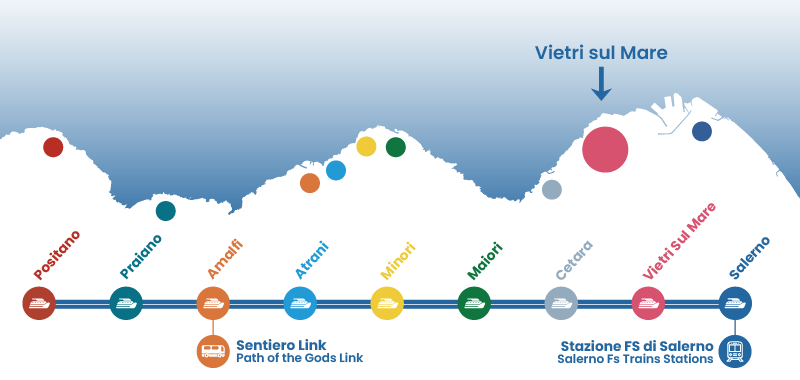Vietri sul Mare
The art of ceramics makes this village a true gem! Admire the beautiful, colorful majolica that decorates the houses and churches.
Vietri sul Mare, the capital of ceramics
Vietri sul Mare is the first gem of the Amalfi Coast when arriving from Salerno, making it the easternmost part of the region and the most populated town. Historically, it is identified with the ancient Marcina, an Etruscan-Samnite coastal settlement that later became a Roman port, used by ships transporting agricultural products and wine from the Nocera-Sarno area. Its breathtaking landscapes and the ancient art of ceramics, dating back to the 1600s and a symbol of this land, make this village a true jewel. The historic center is a magical place where ceramics take center stage, while its two viewpoints offer stunning panoramic views.

The numerous shops that display artifacts of all kinds - dishes, ashtrays, amphorae, decorated tile panels, vases, statuettes, tea and coffee facilities, sacred objects and ornaments of all kinds - make the narrow streets that climb towards the ancient village, an open-air museum where the art of ceramics reaches levels of excellence.
Among the many ceramic objects, the donkeys are very famous. The Vietri donkeys, created by Richard Dolker, a German potter who, since the '20s, attracted by the tradition of ceramics, but also by the sun and the sea of Vietri, moved there, becoming the leader of an exodus of artists from Northern Europe, known as the "Germans of Vietri" who revolutionized the Vietri ceramic style.
What to see and what to do in Vietri sul Mare?
\1
Cathedral of San Giovanni Battista
The Church of San Giovanni Battista, dedicated to San Giovanni, the patron saint of the city, was built in the 10th century as a private church and is also known as the Cathedral of Vietri. Destroyed by the Saracens and remodeled several times over the centuries, it now features a 16th-century façade and a Baroque interior. The element that distinguishes it, making it a symbol of the city, is its majolica-covered dome. Visible from various points in the city, the dome, along with the bell tower, is adorned with yellow, green, and blue fish-shaped majolica tiles, known as "scandole," which are characteristic of the domes in the Amalfi Coast.
\2
Arciconfraternita della Santissima Annunziata e del Rosario
Right next to the Cathedral, the building housing it, originating from the 17th century, is decorated on the façade with painted ceramics depicting religious scenes. Its interior was frescoed in the 18th century.
\3
The Solimene ceramic factory
The headquarters of Solimene Artistic Ceramics, which has been operating in Vietri sul Mare for over a century, houses a vast collection of contemporary ceramics. Designed by the architect Paolo Soleri in the 1950s, it is considered one of the most significant Italian buildings of the 1900s.
\4
The Villa Comunale
Just a few steps away from the Solimene Factory, this is the perfect expression of Vietri ceramics. Its architectural forms resemble Barcelona’s Parc Güell. The brightly colored ceramics that cover the handrails and walls of the villa make this place unique. Its amphitheater, especially in spring and summer, hosts artistic and cultural events.
\5
Villa Guariglia, Museum of Vietrese Ceramic
Located in the village of Raito, in Villa Guariglia you will see displayed many handcrafted products, from the 17th century to the second half of the 20th century.
\6
Marina di Vietri and the other beaches
In Marina di Vietri, there is a charming beach, one of the most recent on the entire Amalfi Coast, having formed in 1954 after a flood that carried mud and debris downstream. Nearby, you will find a narrow street renowned for its vibrant colours, popular on social media, and perfect for Instagram-worthy photos. Along the seafront, you will see two twin rocks, the famous Due fratelli (two brothers), also known as Faraglioni di Vietri.
The Baia beach is one of the few sandy beaches and one of the longest and widest in the area, stretching 400 meters in length. Crespella Beach is named after its Torre Crespella, a watchtower dating back to the 16th century. Marina di Albori is the beach of one of Italy’s most beautiful villages; it enjoys more sunlight compared to others and is accessible via a staircase not far from the center.
\6
Raito, Albori and the other hamlets
Raito became famous because the Italian TV series Capri was filmed at Villa Guariglia, which was called Villa Isabella in the show. The village is renowned worldwide for its characteristic staircases. Raito has only two streets, one in the upper part and one in the lower part of the town, which are well connected by local Vietri bus lines.
The village of Albori, located about 2 km from the center of Vietri, is characterized by narrow streets and brightly colored houses. These vivid hues helped sailors find their homes after long months at sea. Albori is part of the "I Borghi più Belli d'Italia" (The Most Beautiful Villages in Italy, an association dedicated to promoting and preserving Italy's most charming and picturesque villages ) and is home to the Museum of Vietrese Ceramics and the Historical Documentation Center of the Salernitan Medical School.
Other fractions of Vietri include Benincasa, Molina and Dragonea. The latter houses the Church of Santi Pietro e Paolo Apostoli, a millennial parish and one of the oldest in the province of Salerno.




